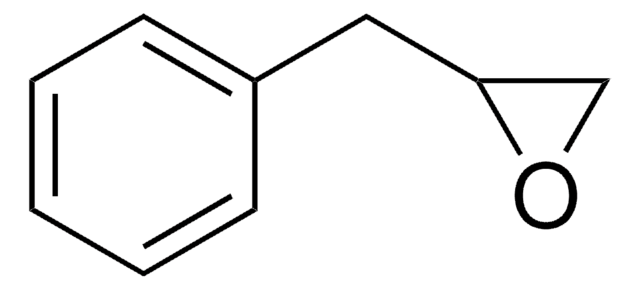248487
1,2-Epoxy-3-phenoxypropane
99%
Synonyme(s) :
2,3-Epoxypropyl phenyl ether, Glycidyl phenyl ether, Phenyl glycidyl ether
About This Item
Produits recommandés
Densité de vapeur
5.2 (vs air)
Pression de vapeur
0.03 mmHg ( 20 °C)
Essai
99%
Forme
liquid
Indice de réfraction
n20/D 1.53 (lit.)
n20/D 1.530 (lit.)
pb
245 °C (lit.)
Pf
3.5 °C (lit.)
Densité
1.109 g/mL at 25 °C (lit.)
Chaîne SMILES
C1OC1COc2ccccc2
InChI
1S/C9H10O2/c1-2-4-8(5-3-1)10-6-9-7-11-9/h1-5,9H,6-7H2
Clé InChI
FQYUMYWMJTYZTK-UHFFFAOYSA-N
Vous recherchez des produits similaires ? Visite Guide de comparaison des produits
Catégories apparentées
Application
- Stable Fe (III) phenoxyimines as selective and robust CO2/epoxide coupling catalysts: This paper discusses the catalytic performance of Fe(III) phenoxyimines with 1,2-epoxy-3-phenoxypropane (Fazekas et al., 2018).
Mention d'avertissement
Danger
Mentions de danger
Conseils de prudence
Classification des risques
Acute Tox. 4 Inhalation - Aquatic Chronic 3 - Carc. 1B - Muta. 2 - Skin Irrit. 2 - Skin Sens. 1 - STOT SE 3
Organes cibles
Respiratory system
Code de la classe de stockage
6.1C - Combustible acute toxic Cat.3 / toxic compounds or compounds which causing chronic effects
Classe de danger pour l'eau (WGK)
WGK 3
Point d'éclair (°F)
237.2 °F - closed cup
Point d'éclair (°C)
114 °C - closed cup
Équipement de protection individuelle
Eyeshields, Faceshields, Gloves, type ABEK (EN14387) respirator filter
Faites votre choix parmi les versions les plus récentes :
Déjà en possession de ce produit ?
Retrouvez la documentation relative aux produits que vous avez récemment achetés dans la Bibliothèque de documents.
Les clients ont également consulté
Notre équipe de scientifiques dispose d'une expérience dans tous les secteurs de la recherche, notamment en sciences de la vie, science des matériaux, synthèse chimique, chromatographie, analyse et dans de nombreux autres domaines..
Contacter notre Service technique











